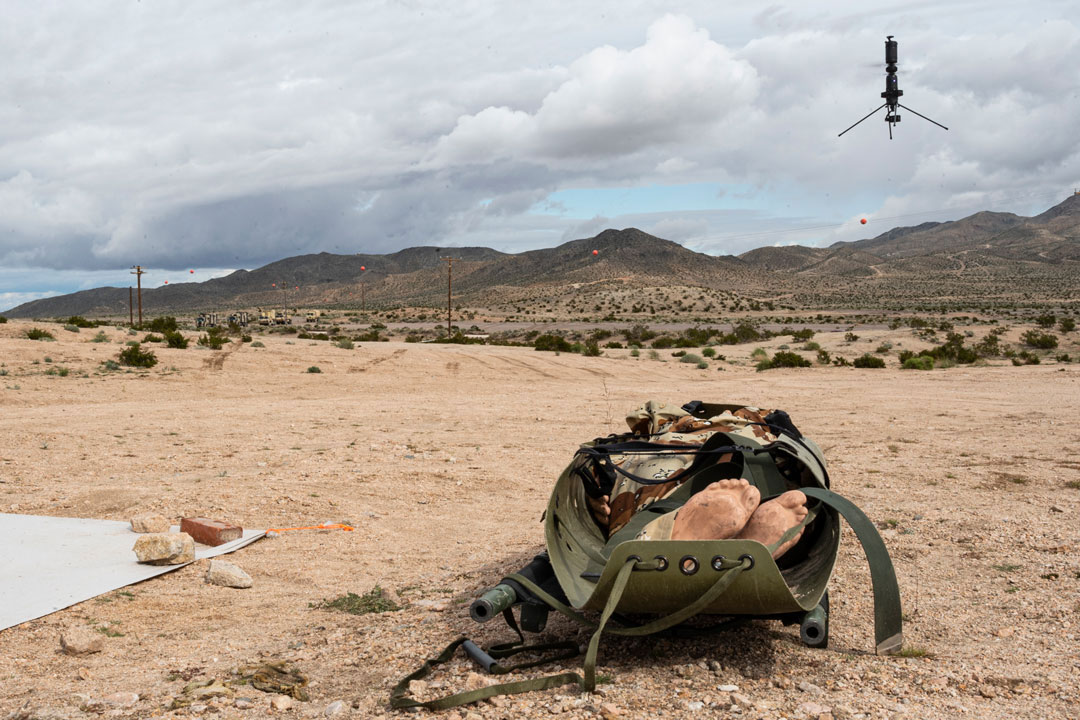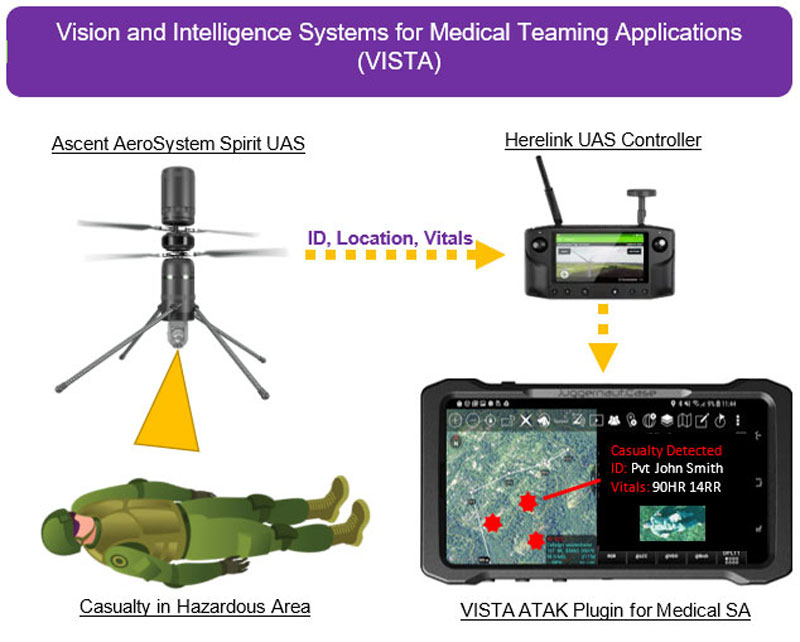TATRC experiments with Medicine Across the Continuum of Care at PC-C4
Friday, August 30, 2024 | Download PDF
 A small unmanned aircraft system (s-UAS) component of the Vision and Intelligence Systems for Medical Teaming Applications (VISTA) hovers while gathering information from notional casualties during the medical experimentation portion of Project Convergence Capstone 4 (PC-C4), Fort Irwin, Calif., March 16, 2024.
A small unmanned aircraft system (s-UAS) component of the Vision and Intelligence Systems for Medical Teaming Applications (VISTA) hovers while gathering information from notional casualties during the medical experimentation portion of Project Convergence Capstone 4 (PC-C4), Fort Irwin, Calif., March 16, 2024. In the U.S. Army’s Telemedicine and Advanced Technology Research Center (TATRC) at Ft. Detrick, MD, teams of researchers, scientists, and engineers work to push the boundaries of military medicine and explore new ways to aid the warfighter.
Projects such as the Remote Patient Management System (RPMS) and Vision and Intelligent Systems for Medical Teaming Applications (VISTA) are iteratively tested, observed, and improved to be built into more capable technologies.
At TATRC, the laboratory environment provides a reliable, controlled environment to test initial concepts and rapidly develop new technologies. However, the true battlefield conditions in which theses future technologies will need to be deployed are not so hospitable, reliable, (or air conditioned). Therefore, TATRC strives to continuously bring early-stage technologies into the field and push them to their limits.
In February through March 2024, TATRC participated in the Project Convergence Capstone 4 (PC-C4) Experimentation at the U.S. Army’s National Training Center at Ft. Irwin, CA. to experiment and put these technologies to the test ‘in the dirt.’
The purpose of this experiment was to research promising medical technology capabilities from across the military medical technology research and development ecosystem in replicated battlefield settings with Soldiers. The various technologies were integrated together and employed alongside one another in simulated patient care scenarios to conceptualize future military medical care.
Active-duty military medical personnel supported the event by utilizing the various technologies while providing simulated casualty care, and provided feedback about the functionality, usability, and overall impact on care. PC-C4 provided a rare and valuable opportunity to see these technologies perform first-hand. Not only does this showcase the successes of the technologies on hand, but, arguably and more importantly, highlights shortcomings and opportunities for technology improvement. At PC-C4, learning from our shortcomings is just as important as our successes. In the end, we want to put forward the best capability for our Service Members.
TATRC was selected to support two technologies at this year’s event: RPMS and VISTA.
RPMS is an interoperable medical device platform that supports remote control and monitoring of life-sustaining care, such as ventilation and infusion delivery. This can improve the quality of care in forward environments, as well as serve as a force multiplier for highly skilled clinicians to assist local care providers in various locations across the operational landscape.
VISTA is a computer vision software capable of stand-off casualty identification and physiological vitals signs assessment deployed on a standard Uncrewed Aerial System (UAS).
 Diagram of VISTA, a computer vision software capable of stand-off casualty identification and physiological vitals signs assessment deployed on a standard Uncrewed Aerial System (UAS).
Diagram of VISTA, a computer vision software capable of stand-off casualty identification and physiological vitals signs assessment deployed on a standard Uncrewed Aerial System (UAS).Both technologies alone have clear potential to improve battlefield medical care and modernize military capabilities. However, the truly revolutionary concept is the integration of these technologies and their data into a unified system across the continuum of care.
When RPMS and VISTA, along with the wide range of other emerging medical technologies are combined, their shared medical data can be used to track patient status, inform logistics operations, optimize care, and, eventually, automate entire portions of the medical care process.
As an example of what these future concepts may look like, an injured casualty can be identified and initially triaged with VISTA, with the data initiating a patient record. Once a medic stabilizes the patient and recovers them to a Role II, the RPMS can access this patient record to identify key information such as injury profiles, changes in vital signs since initial identification, and time since injury. This information is then relayed to a remote expert who can optimize care delivery and track them throughout their evacuation from the field.
This vision of medicine is what TATRC aims to achieve. Experimentation at events such as PC-C4 provide a unique and valuable opportunity to glimpse the potential of these ideas in action.
For more information on these initiatives, please contact Mr. Nate Fisher at: nathan.t.fisher3.civ@health.mil.
This article was published in the August 2024 issue of the TATRC Times.